Understanding liners, and their appropriate uses
Most of our plastic CT or metal CT caps (CT stands for continuous thread) comes with a liner. While there are many different liners out on the market today, we stock several commonly used liners for different applications (solid, liquid, essential oil, powder, carbonated liquid, food, etc.). It is important to understand what these liners are commonly good for, and make your closure selection beyond overall looks alone.
Liner serves as a barrier that provide additional seal between your cap and bottle, and in some cases it also provides a tamper evident seal. Common liner types at bottlestore.com are:
- F217
- PE foam
- Pulp & Poly
- Pulp & Foil
- Plastisol
- HS035
- PS22
- PE cone
F217 and PE foam
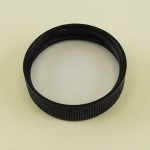 Generally good for liquid products and commonly found in our plastic CT caps, it is a white colored foam type liner. PE foam is essentially a generic version of the F217 liner, trademarked by the Tr-Seal company.
Generally good for liquid products and commonly found in our plastic CT caps, it is a white colored foam type liner. PE foam is essentially a generic version of the F217 liner, trademarked by the Tr-Seal company.
Pulp & Poly
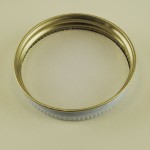 This liner is made of two layers of material: Pulp, which is a cardboard type material, which faces the cap and polyvinyl chloride (PVC), which faces the product. This liner is commonly found in our metal CT caps, and is generally suitable for solid or liquid food items such as jams and jellies.
This liner is made of two layers of material: Pulp, which is a cardboard type material, which faces the cap and polyvinyl chloride (PVC), which faces the product. This liner is commonly found in our metal CT caps, and is generally suitable for solid or liquid food items such as jams and jellies.
Pulp & Poly liner looks white and shiny.
Pulp & Foil (PAF)
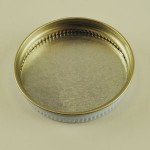 This liner is similar to Pulp & Poly, except that the product facing layer is foil rather than PVC. This liner is commonly good for product in solid or powder form.
This liner is similar to Pulp & Poly, except that the product facing layer is foil rather than PVC. This liner is commonly good for product in solid or powder form.
Pulp & Foil liner looks silver and shiny.
Plastisol
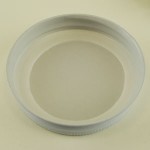 Plastisol is a foamy type PVC component which is sprayed onto the metal cap. This liner is best used when applied at 140 degrees, as the liner softens and a hermetic seal is archived with the lip of the bottle. It’s application is common with glass bottles and jars with food products.
Plastisol is a foamy type PVC component which is sprayed onto the metal cap. This liner is best used when applied at 140 degrees, as the liner softens and a hermetic seal is archived with the lip of the bottle. It’s application is common with glass bottles and jars with food products.
Plastisol liners are white in color, cannot be separated from the cap by hand, and foamy to the touch.
HS035
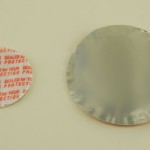 This is a speciality induction seal liner that requires a induction sealing equipment to apply as the liner sticks to the bottle to provide a tamper evident seal. When being applied, a electromagnetically activated layer bond with the lip of the bottle, given consumer a tamper evident assurance on the shelf.
This is a speciality induction seal liner that requires a induction sealing equipment to apply as the liner sticks to the bottle to provide a tamper evident seal. When being applied, a electromagnetically activated layer bond with the lip of the bottle, given consumer a tamper evident assurance on the shelf.
HS035 commonly looks silver on product facing side and often printed with “sealed for your protection” on consumer facing side.
PS22
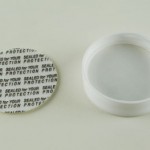 This pressure sensitive liner is trademarked by the Tekni-plex company. It provides similar tamper evident properties as the HS035 but does not require an induction sealing equipment to apply. It is simply “pressure applied” by closing the cap in place with specific torquing requirements. It provides good sealing properties for dry products in either glass or plastic bottles.
This pressure sensitive liner is trademarked by the Tekni-plex company. It provides similar tamper evident properties as the HS035 but does not require an induction sealing equipment to apply. It is simply “pressure applied” by closing the cap in place with specific torquing requirements. It provides good sealing properties for dry products in either glass or plastic bottles.
PE Cone
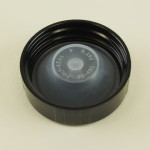 PE cone liners are commonly found in our Phenolic and Urea plastic caps. It is ideal for use with glass bottles and our amber pour-out glass bottles. This cone shaped liner provides a good seal on the lip of the bottle for essential oil or carbonated products.
PE cone liners are commonly found in our Phenolic and Urea plastic caps. It is ideal for use with glass bottles and our amber pour-out glass bottles. This cone shaped liner provides a good seal on the lip of the bottle for essential oil or carbonated products.
PE cone liner is easily identified as it is natural plastic in color and it is cone shaped.
How can we help?
Not sure which liner to choose for your product? Comment below or call us. Our packaging engineers will be able to answer your questions. It is important to note that while our professionals will be able to answer your questions, product compatibility testing should still be conducted to ensure proper fitment and compatibility. For details about our product compatibility testing disclaimer, please click here.

What caps are acceptable with olive oil?
Thanks for the question, here is a quick answer:
Hope this helps.
what are standard capacity and mouth plastic jars for drug?
Commonly speaking pharmaceutical products in solid pill form are generally packed in round packers. Capacity of these bottles are generally measured in cc, or ml.
we need a 8 ounce bottle with a pump top. Does item number 8007070 have a pump option? if not, do you have a 8 ounce bottle with a pump. we need 50 of them to put hand sanitizer in it.
You could insert a pump top with this particular 8oz Flint Boston Round – SKU 6352029. On glass bottles the transfer bead generally are too thick for any pump to go through, but this particular one has its transfer bead trimmed down to allow pumps to go through.
What would work well with essential oils? And can I buy just the liner?
Thanks
Essential oil are generally safe with a wide variety of lined caps. However, depending on other ingredients there may be exceptions. Typically if you are purchasing a metal cap you can choose one with PAF liner.
However, liners are not generally available by itself, they are always sold with caps as these type of liners are glued onto the inside of the cap.
What kind of cap work with honey? Thanks!
which cap is better for saving homemade liqueur
Hi there,
Caps with F217 or LDPE cone liner are generally good for liquor packaging. For best results we recommend testing it out for about 10 days at least to determine compatibility.
Hi, What would work for Kombucha? The PE Cone? I am wanting to lock in carbonation.
Thanks!
While I can’t be 100% sure, you can try metal caps with Plastisol liner first. PE cone may do the trick but I’ve seen most common uses with Plastisol. Hope this helps!
Metal is not compatible with kombucha. I also have the same question about what lid is best for kombucha under fermenting pressure, compatible with your 16 oz flint glass jar, and whether the cap is reuseable. Thanks.
I’d be open to suggestions for other 16oz bottle/lid combinations , since the flint wide mouth bottle is limited to the F217 option in a non-metal top.
Which type of liners are best used with your CT aluminum lids (e.g. 43/400 and 70/400 and 89/400) to go with plastic jars containing skin care creams?
Working with 4 oz plastic jars filled with salt and oils. No matter what seal we seem to try they leak. I am looking for a metal type seal that will keep oils from leaking out, even when shipped over the rockies, can you help?
Hi, my name is Lee and I have the same question as David. Is the PE Cone liner cap best for the kombucha 2nd fermentation process ~ under pressure? I’d be using a 16 ounce glass jar. Thank you
David said on April 4, 2015
Reply
Metal is not compatible with kombucha. I also have the same question about what lid is best for kombucha under fermenting pressure, compatible with your 16 oz flint glass jar, and whether the cap is reuseable. Thanks.
Hello!
What’s the suitable liner seal for packing peanut butter in glass jar? mine is 8 oz wide mouth glass jar.
and the cap is best Pulp & Foil (PAF) or Plastisol?
Thanks
Hello!
i’m having a little home business , i was wondering what’s the suitable liner seal material (foil, paper ….) for packing peanut butter in glass jar? mine is 8 oz wide mouth glass jar.
and the cap is single metal cap, the canning process i think i’m going to have handheld induction machine.
Thanks
We are starting a small business with massage oils and I am having a hard time figuring our which style tamper resistance seal I need.We tried to go with shrink bands but they don’t fit right and are relying the bottle when were heating them.We have a 8 ounce cosmo/bullet style PET plastic bottle with a flip top.If we went with a foil liner or some form of plastic ,which ones work well with essential oil carrier oil blends ? We don’t want the plastic to possibly break down ,and if we need foil liners I would want to make sure we get the right ones.What would you suggest ?
Thanks for your help
Hi,
I am looking for aluminium seal liners thats 115 cm in a large quantity for my food product.
I have a peanut butter spread going in a 4oz glass jar. I need some guidance on the best lid to use or what is acceptable to use for such a product.
Which liner is best for a 500ml FRENCH GALSS BOTTLE OF 4.4cm , I have a problem with my regular caps they have a foam liner but still linking the Kombucha, Any suggestion?
Thank you,
It helps to have an understanding of the properties of your product to find the ideal closure solution. EVA (ethylene-vinyl acetate) disc liners are ideal for complete closure systems to contain products that produce CO2, like kombucha. These liner systems are ideal for carbonated products ranging from soda to vinegar.
Foam liners are great general purpose liners for dry ingredient, oils and liquids but carbon pressure produced by the kombucha can cause the seal to lose contact with the bottle neck landing. This loss of contact can contribute to product loss and therefore leaking.
Hi. I am bottling maple syrup and I am wondering which cap I need to use to create a seal. Once opened maple syrup needs to be stored in the fridge so I am looking for the correct cap that will create a seat until it is opened. I plan to use the 16 ounce boston round bottles. Thank you!
When it comes to maples syrup there are a number of closures and liner systems that are utilized in the market today.
Some of the more popular selections that we find are PP (polypropylene) or metal closures with an F217/Foam Liners and phenolic closure with PE Cone Liners. Each closure system creates a seal on the landing of the neck of the container and will remain until it is initially opened.
Is there a way to sterilize the PE foam liners ? Can they withstand steam / boiling water?
Hi there! I just have a quick question.. I make my own all natural body butter cream with essential oils.. now I am wondering if the metal lid with the F217 liner is the best for not saturating and not taking away the from quality of the oils and butters? It sounds as though it may be right, but would just like a conformation and or at the very least maybe shown a better option for what I am dealing with. I thank you in advance for any help.
Hi Sonya,
Yes PE Foam or F217 would work best for your products. These liners are commonly used for liquid products such as bubble bath formulas, car shampoo, floor cleaners, cold creams, liquid detergents and hand soaps. PE foam and F217 generally looks like a white colored plastic foam.
Generally speaking, PE Foam and F217 liner can be used for both plastic bottles and glass bottles.
What an incredibly helpful article. Thank you!
let me add to my previous question.
We run small business for bathsalt, and will order around 1000pcs. so looking for the perfect closure liner to make products’ shelf life longer.
it seems my previous comments has not been sent.
let me resend this.
I am looking for the LINER of metal closer of amber glass jar which containing essential oil/CBD in it.
closure need liner or no need liner? if closer need liner, which one ( F217, pulp poly, PE, RAF) is the best to keep the essential oil infused bathsalt fresh as possible?
Essential oil is strong and sometimes it penetrate the plastic, so we use metal closer, but al liner seems made of plastic, should we put liner or foil is better?
Hi Jas,
A few quick questions:
1) What is your Closure/Container neck finish
2) Are you looking for a metal or plastic closure?
We would recommend an F217 liner with either a metal or plastic closure. Depending on your product, they can go with a metal unlined closure. We would also recommend a phenolic closure with our foam liner as well (again, pending the neck finish you’re looking for, we have specific sizes of phenolic closures)
Lastly, we would recommend a metal closure with a plastisol liner, that’s a heavy-duty liner if used properly for sealing.
Thank you for your reply.
Our container is 16oz (480ml) Amber Glass Straight Sided Cream Jar Modular Round – 89-405 Neck SKU K6720106, and we want the white color metal closure.
so the most suitable liner for the bathsalt is Plastisol and second one is F217? What is the material of circle part of plastisol liner which facing to the bathsalt?
Thank you for your reply.
Our container is 16oz (480ml) Amber Glass Straight Sided Cream Jar Modular Round – 89-405 Neck SKU K6720106, and we want the white color metal closure.
so the most suitable liner for the bathsalt is Plastisol and second one is F217? What is the material of circle part of plastisol liner which facing to the bathsalt?
Hi, I am bottling vanilla extract in 4 oz Boston brown bottles with PE cone line caps and I was wondering what would be the best way to sterilize the PE cone lined caps? I would like to thank you in advance for taking the time to answer my question and would greatly appreciate your response?